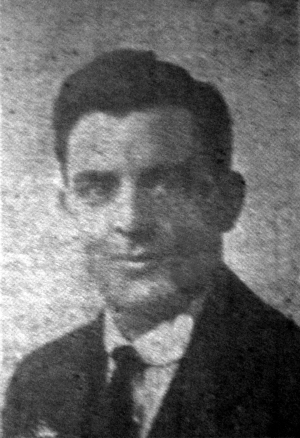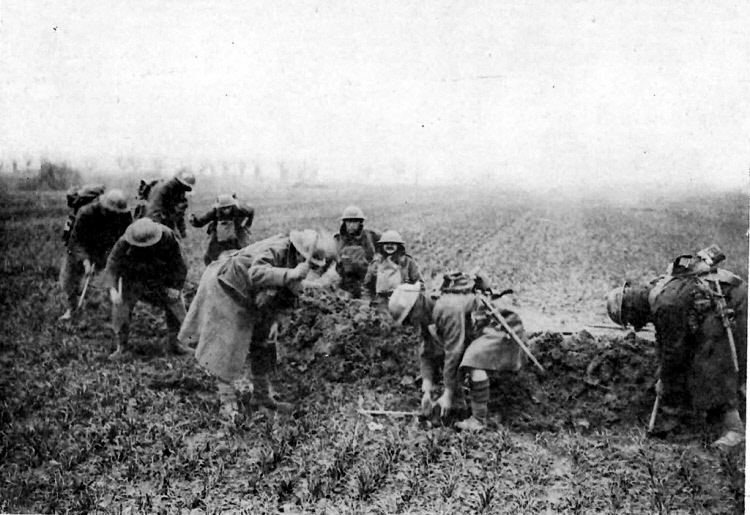
Fred Blackburn was born in Netherton in 1894, the fifth child and fourth son of miner Peter Blackburn and his wife Annie (nee Hargreaves), who married at Thornhill St Michaels Church, Dewsbury on the 25th December 1881. The couple had ten children, but sadly three of them died before April 1911.
In 1901, Peter and Annie Blackburn are living at Haggs Hill, Ossett with their eight children, aged between 2 and 18 years. By 1911, the family had moved to 22, Hope Street, Ossett where Fred, aged 17, was working as a mill hand. Sometime later the family moved to live at 59, Park Square, Ossett.
The 8th Battalion, Royal Scots (Lothian Regiment) was formed in August 1914 at in Haddington and was part of Lothian Brigade, Scottish Coast Defences. The battalion proceeded to France, landing at Le Havre on the 5th November 1914. On the 11th November 1914, the battalion was attached to 22nd Brigade, 7th Division. On the 19th August 1915 they transferred to the 51st (Highland) Division as a Pioneer Battalion.
Pioneer battalions dug roads, trenches and shelters, but were also infantrymen, working at the Front, often under appalling conditions. The battalion’s strong connection with East Lothian’s mining communities was presented as the main reason for their outstanding reputation in the new role. But their reputation was hard-won. In the Somme battle of July 1916 the 1/8th incurred over 100 casualties in one 24 hour period from shellfire as they dug trenches and consolidated other forces’ gains. Of necessity this had to be done in the open and in full view of the Germans. The battalion faced these most dangerous tasks time and time again. So proficient was the battalion in the pioneer role that it often had under command detachments of other new designated pioneers for training.1
The 51st (Highland) Division remained in the Cambrai area until 21st March 1918, when the enemy launched a huge and overwhelming attack on the fronts of Fifth and Third Armies, the Division being in the latter near Flesquieres. The defensive front around Flesquieres formed a salient and was strongly held by the British. The enemy decided not to attack it frontally, but instead drenched it with gas while attacking on either side. The pressure grew during the day, and from early evening the Division began a fighting withdrawal that took it over the next few days back several miles, through Beaumetz, towards Bapaume. In fighting a number of critical rear-guard actions, Divisional losses built up to a total of over 4,900 men.
On the 1st April 1918, the 51st (Highland) Division entrained for the Bethune area where it was hoped things would be quieter. Unfortunately, the enemy opened a second phase of his offensive on the 9th April 1918, and the Highland Division moved into defensive positions behind Richebourg Saint Vaast, where it played a key part in beating off incessant attacks, again at great cost of another 2,500 men.
“The 8th Battalion, Royal Scots was resting and reorganising in the vicinity of Lillers when the enemy made his attack for Merville. The Battalion moved into action behind the River Lawe, and in front of the village of Paradis on the 10th April 1918. The enemy attacked in force during the early morning of the 11th, and during the whole of that day the Battalion bore their fair share of holding the enemy in check. Severe fighting took place in and front of Paradis, but the enemy, after his initial success of crossing the River Lawe, made little progress, and that at great expense. The Battalion had been reinforced by youths of nineteen, who behaved like veterans.” 2
Private Fred Blackburn is recorded as one of the 23 men losing their lives in this action in the War Diary of the 8th Royal Scots.
The “Ossett Observer” had this brief report in 1919:
“Ossett Casualties – Intimation has been received this week by his parents that Private Fred Blackburn, 1/8th Royal Scots, of 59, Park Square, Ossett, who was previously reported missing from April 11th 1918, is now presumed to have been killed on that date. The deceased formerly worked as a warper at Manor Mill. Two of his brothers served in the Army, both being wounded, and are now discharged.”
Fred Blackburn’s army service record has not survived, but he was awarded the British and Victory medals, but not the 1914-15 Star, indicating that he did not serve overseas before the 31st December 1915. The medal card also records an earlier service number of 8394, suggesting that he may have been in the Territorials before the war commenced.

Above: 51st (Highland) Division soldiers digging in near Locon, France, 10th April 1918.
Private Fred Blackburn, aged 24, was killed in action on the 11th April 1918 during the Battle of Hazebrouck, his body was never recovered and he remembered on Panel 10 to 13 at the Loos Memorial, 3 Pas de Calais, France. The Loos Memorial forms the sides and back of Dud Corner Cemetery. Loos-en-Gohelle is a village 5 kilometres north-west of Lens, and Dud Corner Cemetery is located about 1 kilometre west of the village, to the north-east of the N943, the main Lens to Bethune road.
Dud Corner Cemetery stands almost on the site of a German strong point, the Lens Road Redoubt, captured by the 15th (Scottish) Division on the first day of the battle. The name “Dud Corner” is believed to be due to the large number of unexploded enemy shells found in the neighbourhood after the Armistice.
The Loos Memorial commemorates over 20,000 officers and men who have no known grave, who fell in the area from the River Lys to the old southern boundary of the First Army, east and west of Grenay. On either side of the cemetery is a wall 15 feet high, to which are fixed tablets on which are carved the names of those commemorated. At the back are four small circular courts, open to the sky, in which the lines of tablets are continued, and between these courts are three semicircular walls or apses, two of which carry tablets, while on the centre apse is erected the Cross of Sacrifice.
References:
1. The 8th (Territorial) Battalion of the Royal Scots in World War One
2. 8th Royal Scots at War